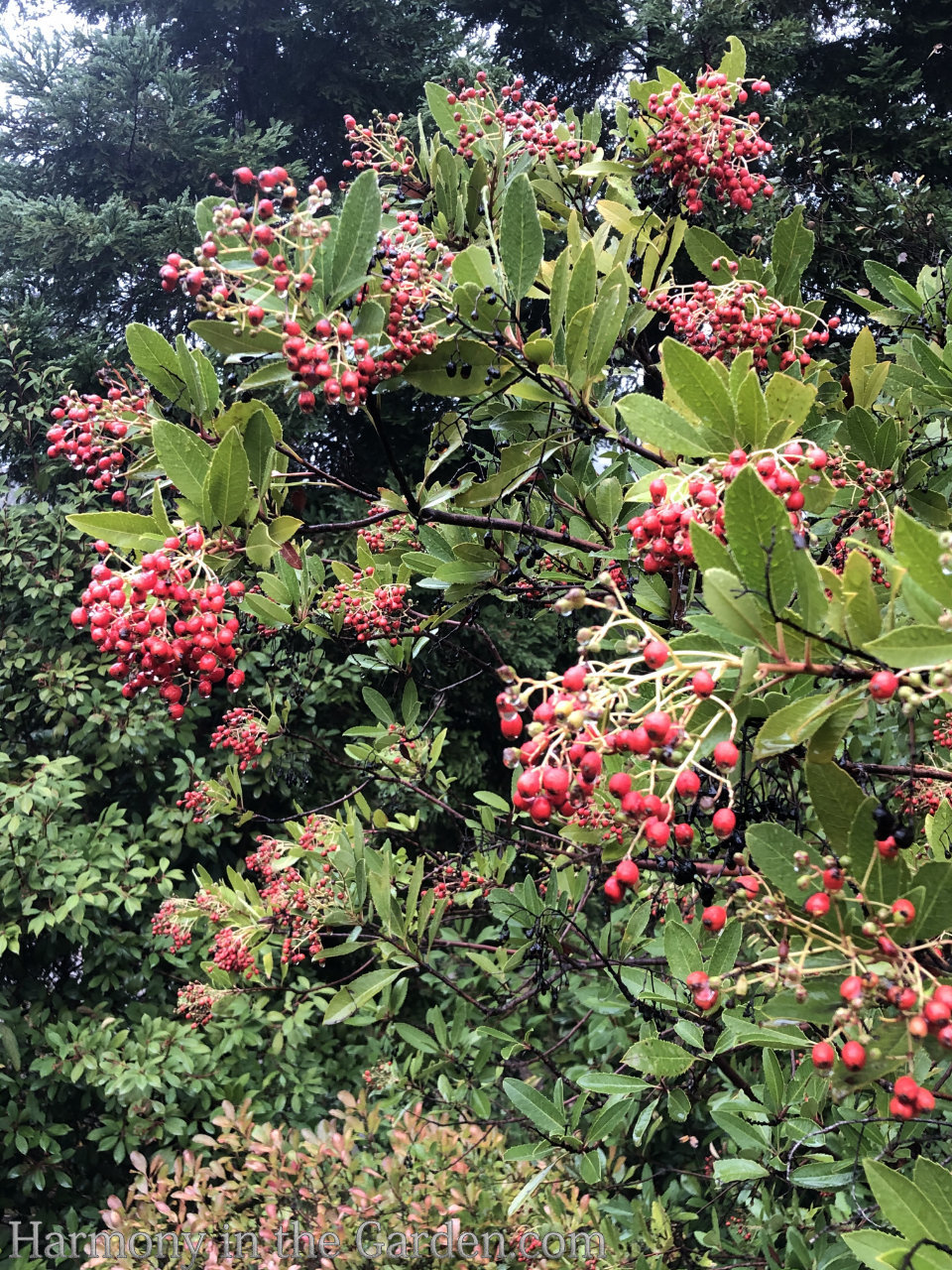
Winter berries in the garden are a treat for gardeners craving color during these cold and rainy months, but more importantly for hungry birds.
Winter berries are filled with sugar and fat for birds, helping them to withstand freezing temperatures and sustain them during their migration.
Even as I write this, the shrubs and trees in my garden are filled with various birds feasting on the berries that are just now ripening (in particular, the toyon and dogwood.)
I consider my garden a re-fueling station for many of these birds, and it brightens my day to see them taking a break from their winter migration.
There are so many varieties of trees, shrubs, and vines that produce berries in the winter, but the following are some of my favorites I’ve used over the years.
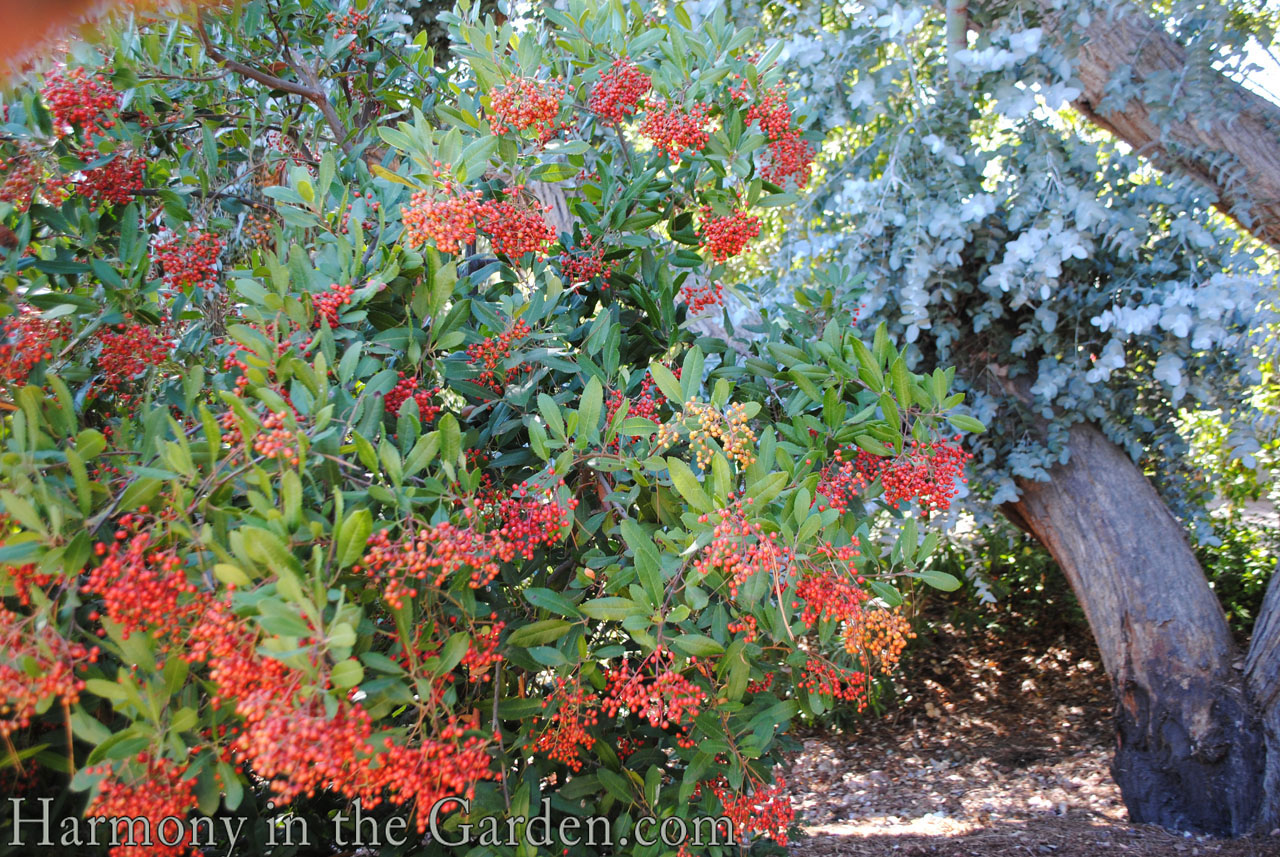
Toyon (Heteromeles arbutifolia) zones 7-11
One of my favorite shrubs for winter berries is our native Toyon (Heteromeles arbutifolia).
Not only do I appreciate that this large shrub (growing up to 20 feet!) is evergreen, but look how the bright red berries pop against the dark green foliage.
And when placed near the gray eucalyptus tree – heaven!
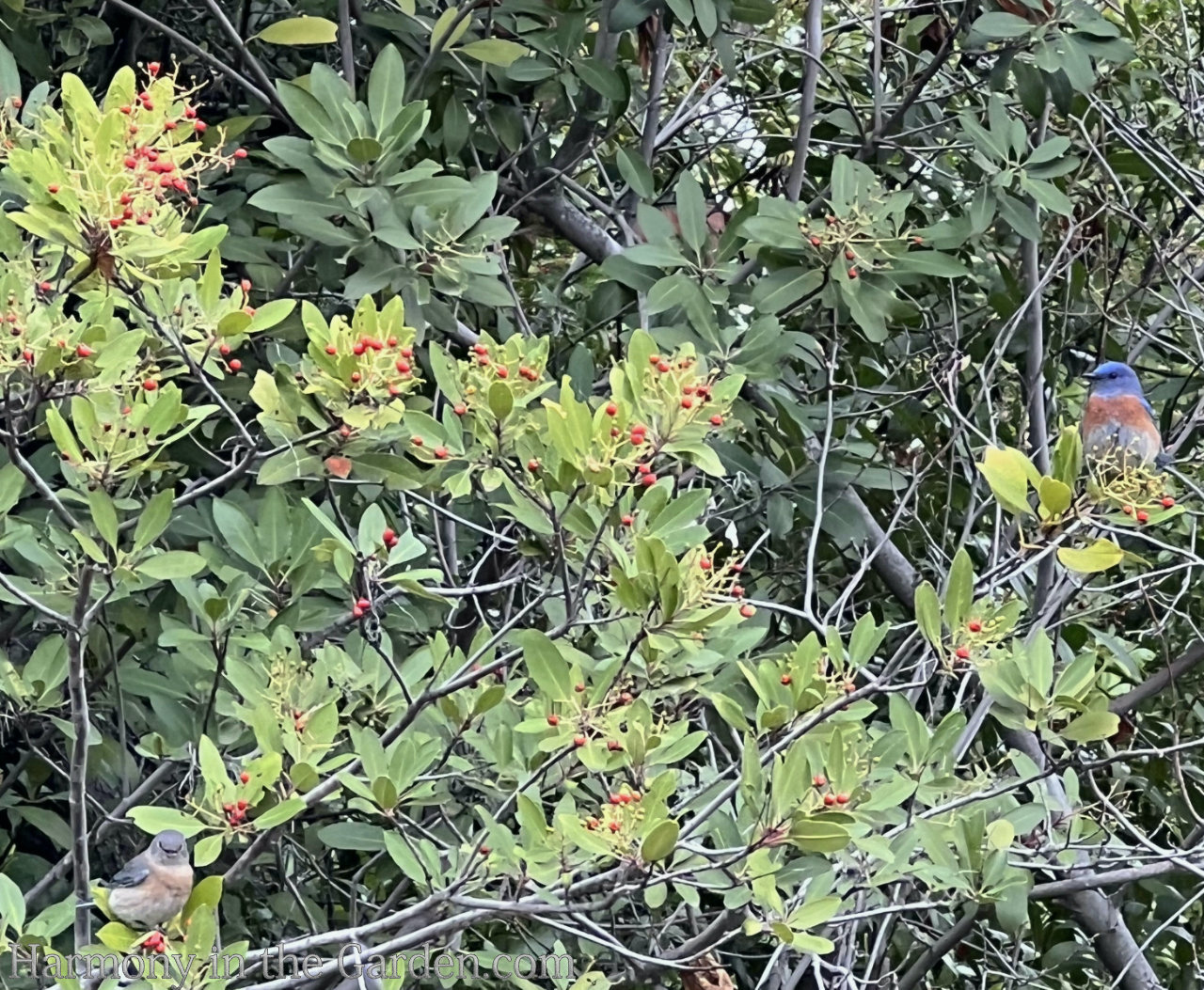
It’s clear I’m not the only one who adores toyon berries. Once they’ve hit their beauty’s peak, bluebirds and robins swoop in to strip the shrub within a few hours.
Ah well, it was beautiful while it lasted!
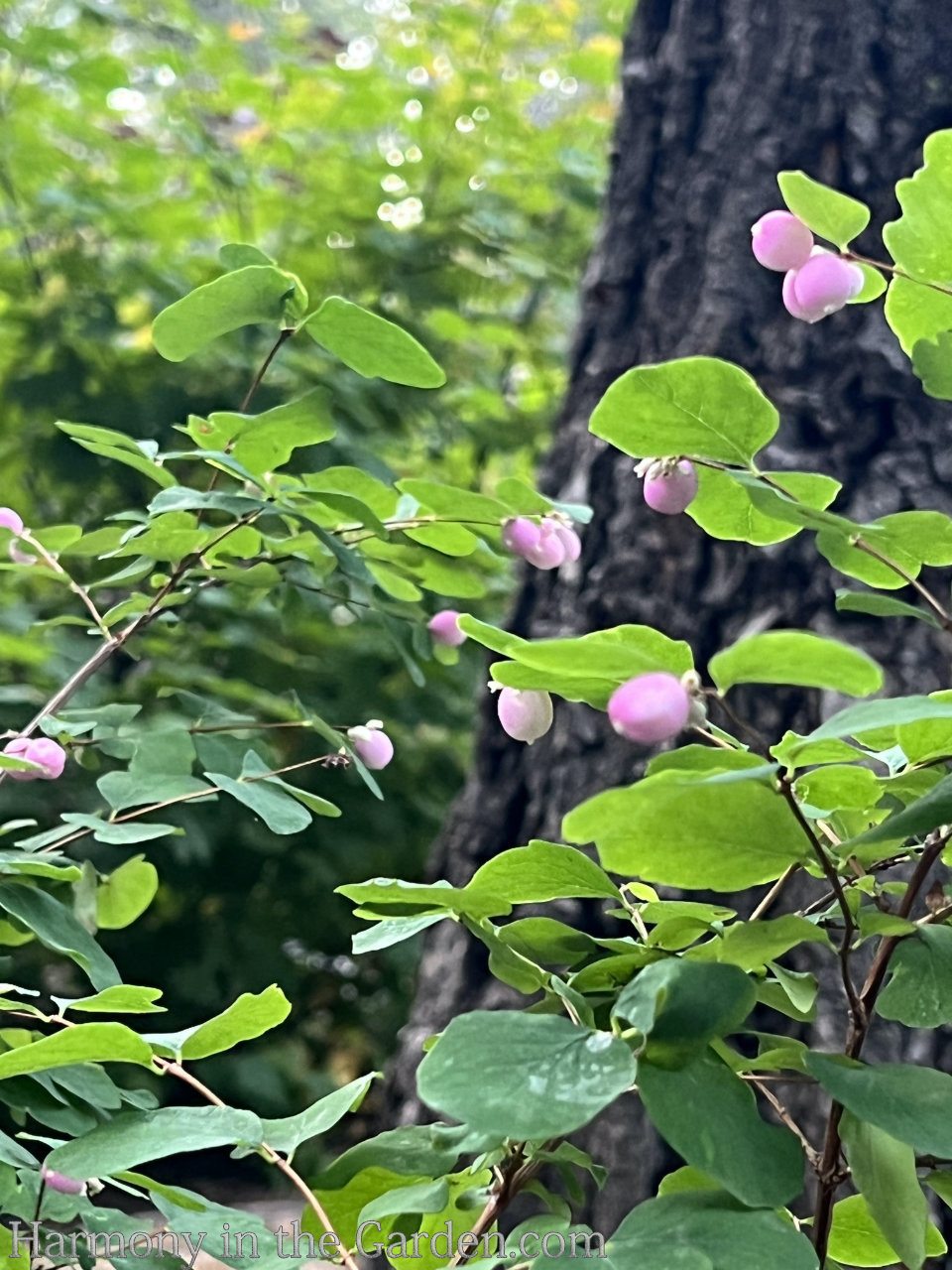
Symphoricarpos ‘Proud Berry’ (Snowberry) zones 3-7
When mentioning snowberries, most people think of the white variety.
But did you know they also come in bright pink, like Proven Winner’s ‘Proud Berry’ (left) or soft pink, like Monrovia’s ‘Charming Fantasy’?
Personally, I love all three and have them in our zone 6 garden at Lake Tahoe.
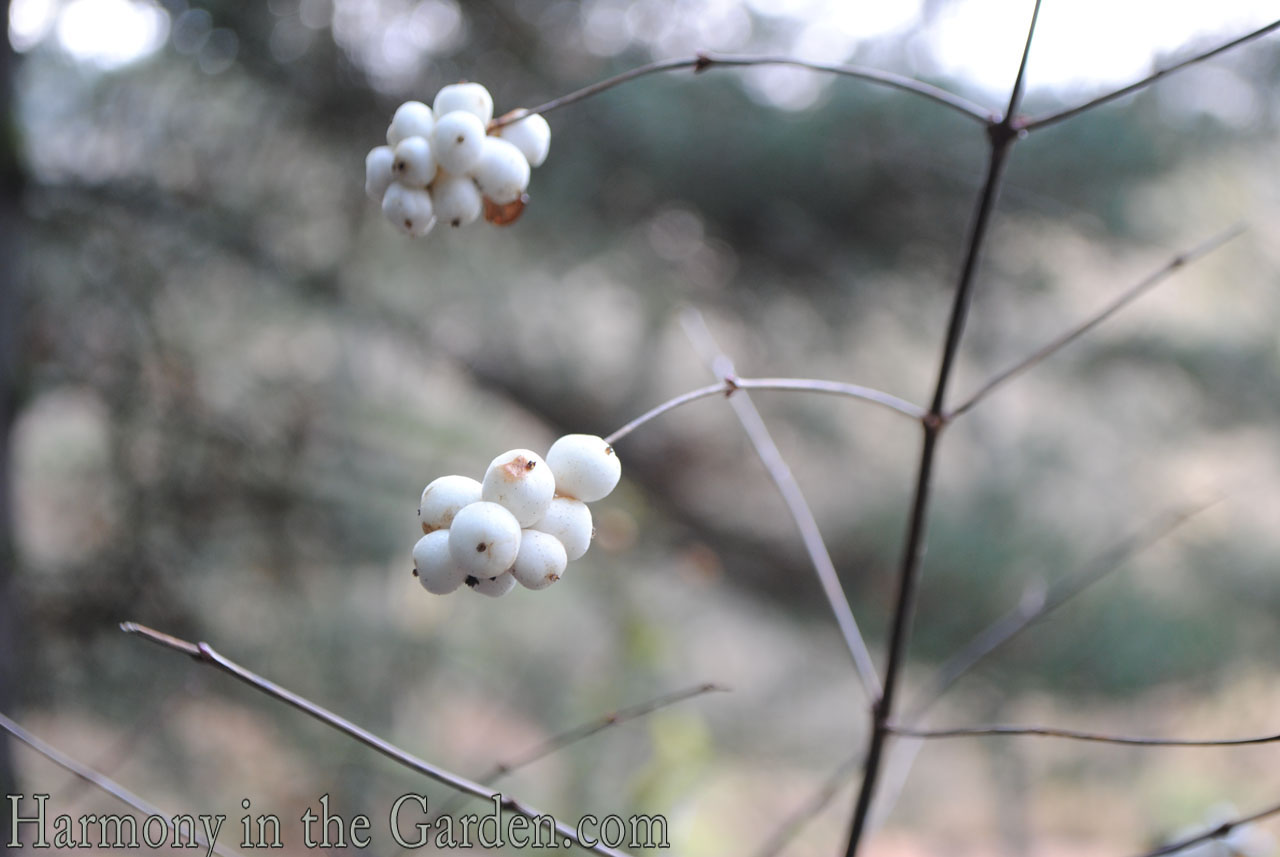
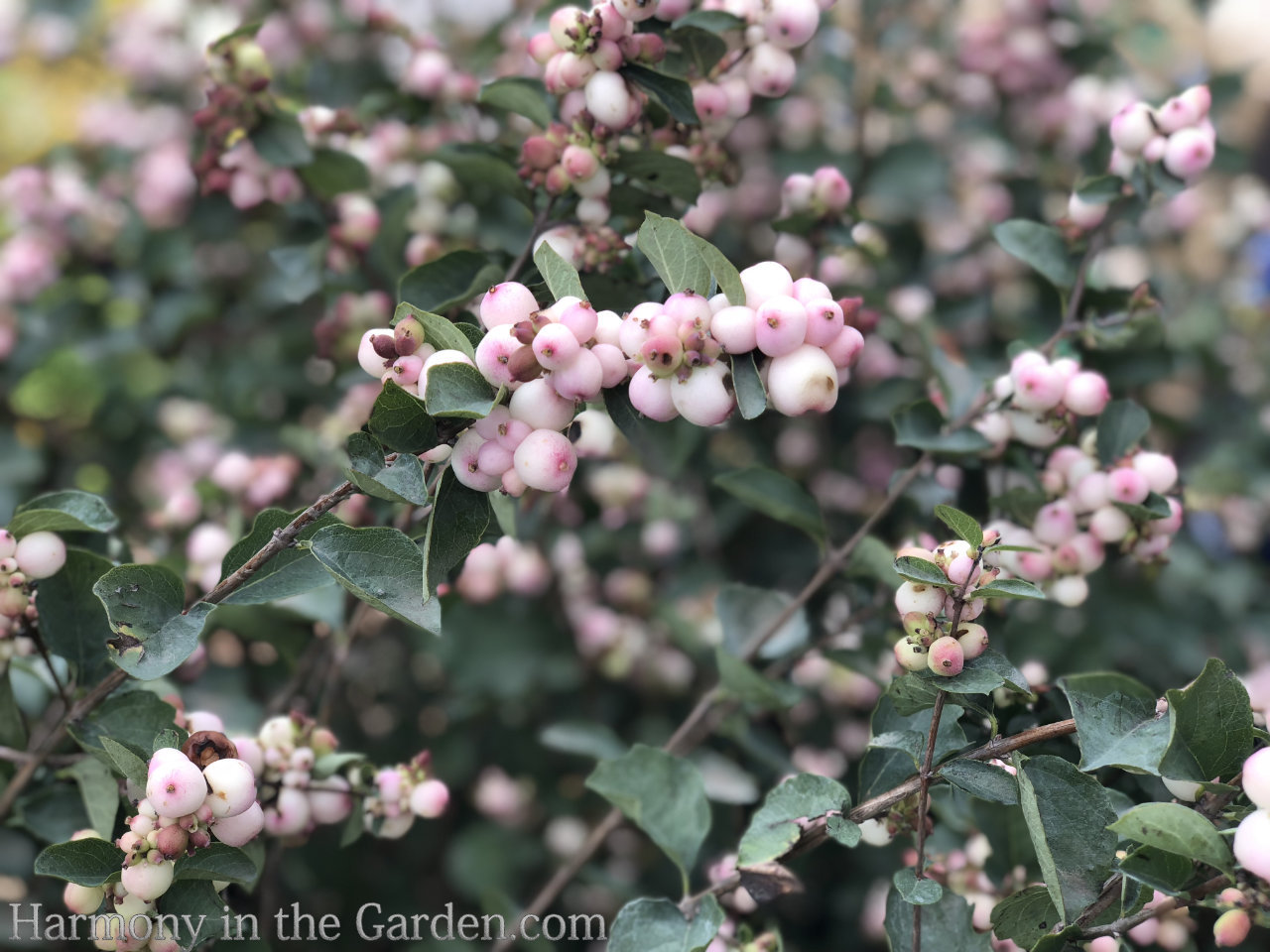
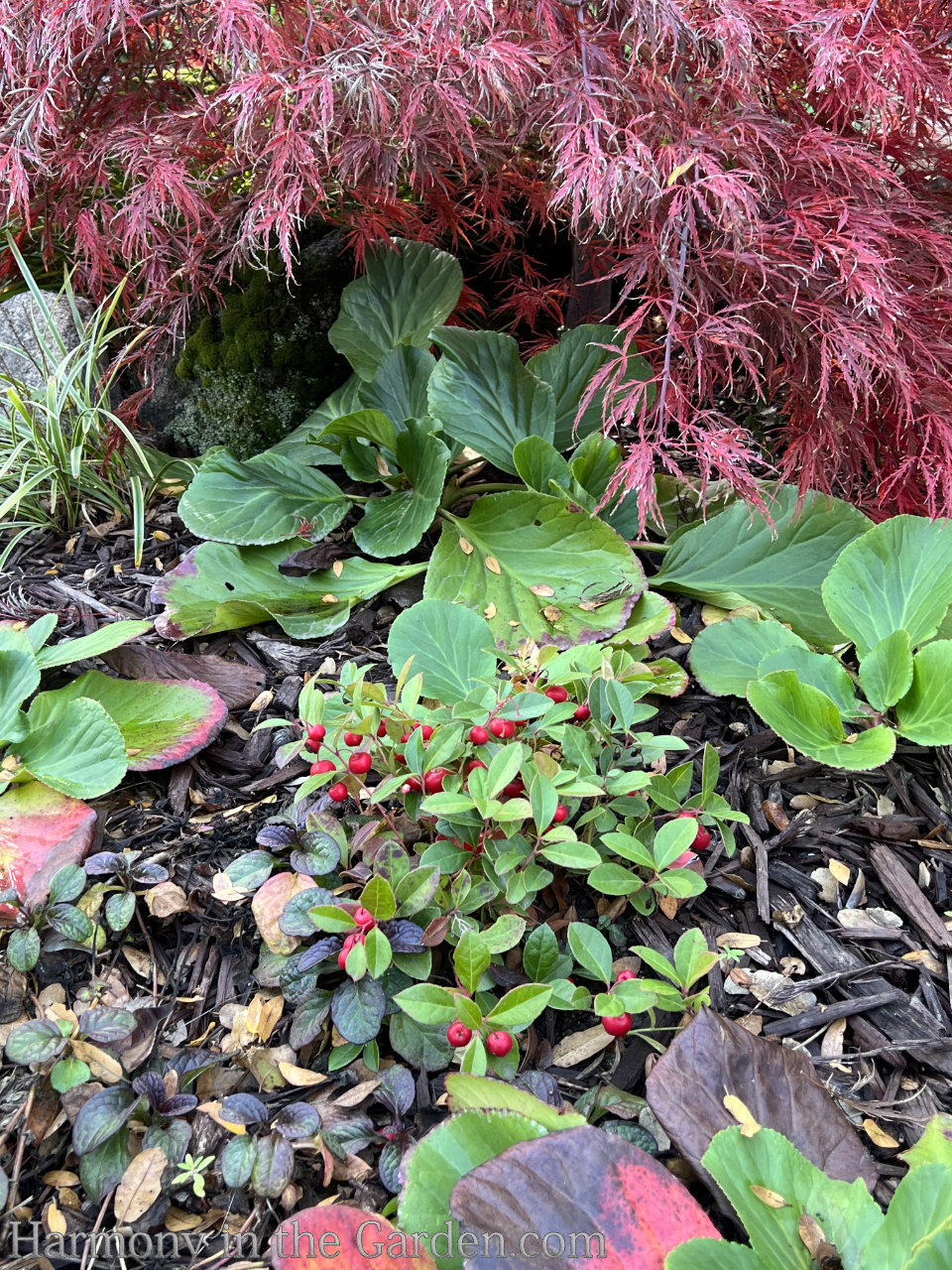
Gaultheria procumbens (Wintergreen) zones 3-9
I have several wintergreens growing in my garden and have been amazed at how tough they are!
I have them planted at the bottom of my hill (where the water table is naturally high, providing the moisture they want.)
They’ve survived hot summer temps of 100+, a maurading squad of 17 turkeys, and hungry deer. Not a nibble or scorched leaf to be found!
Plus, the berries are edible and have a unique wintergreen taste.
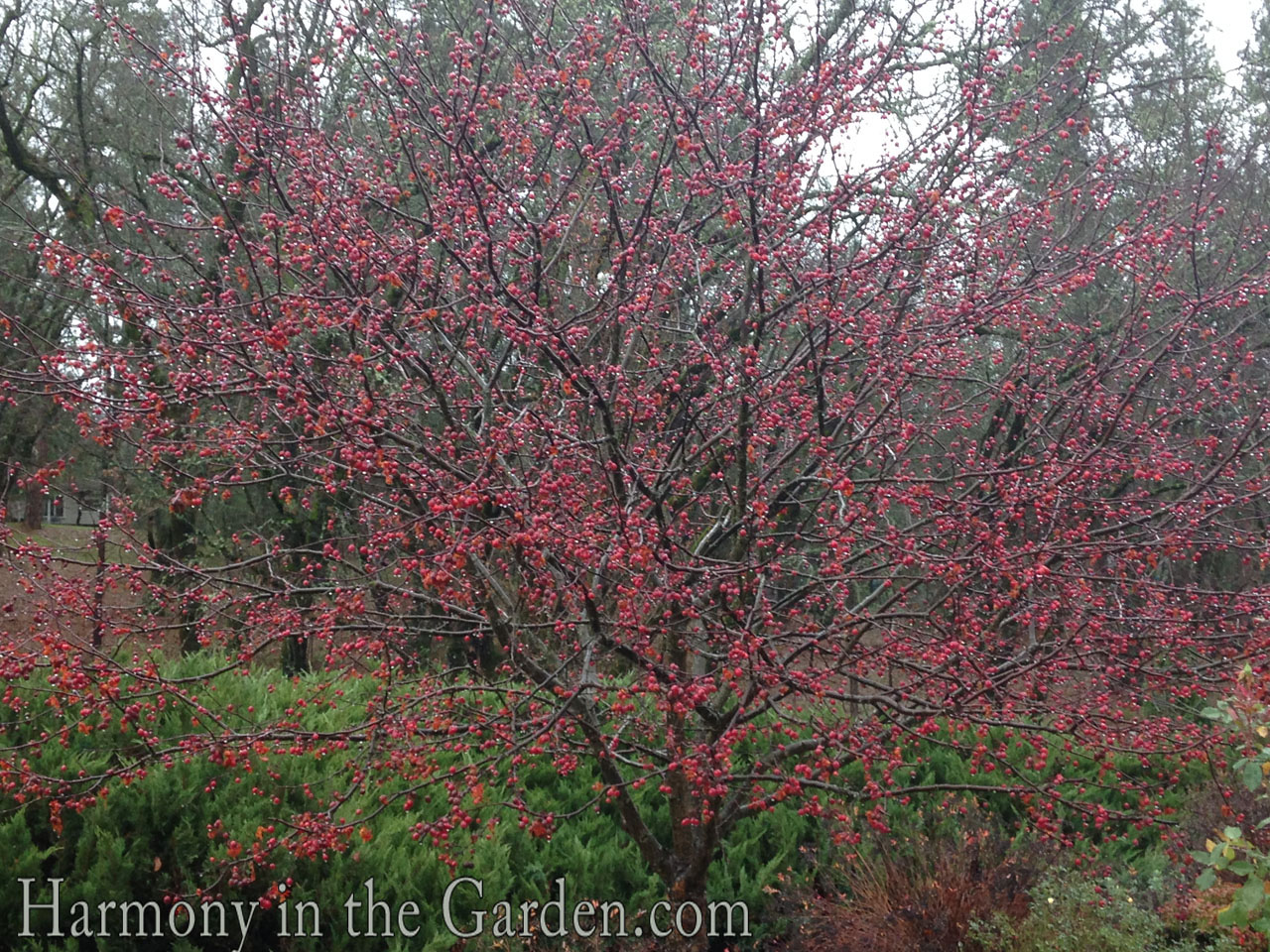
Malus ‘Adam’ (Crabapple) zones 4-8
My mother’s ‘Adam’ crabapple tree is, hands-down, the most stunning variety I’ve ever seen.
This mid-sized tree is covered in hundreds of cranberry-red fruits that hang on well into January.
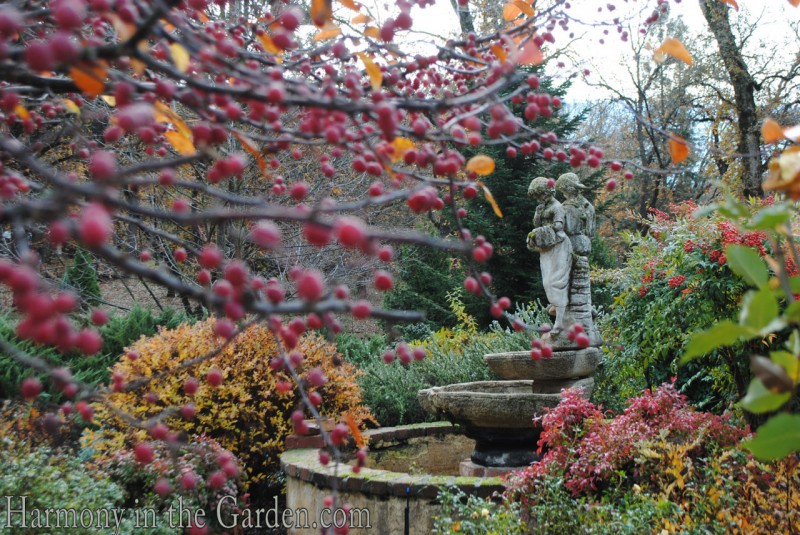
This tree was in my mother’s previous garden (zone 8), and despite its showy red flowers and fiery fall foliage, it’s the red berries that would steal the show.
I particularly love the winter color echo created with the red crabapple berries and the nearby nandina’s red foliage and red berries.
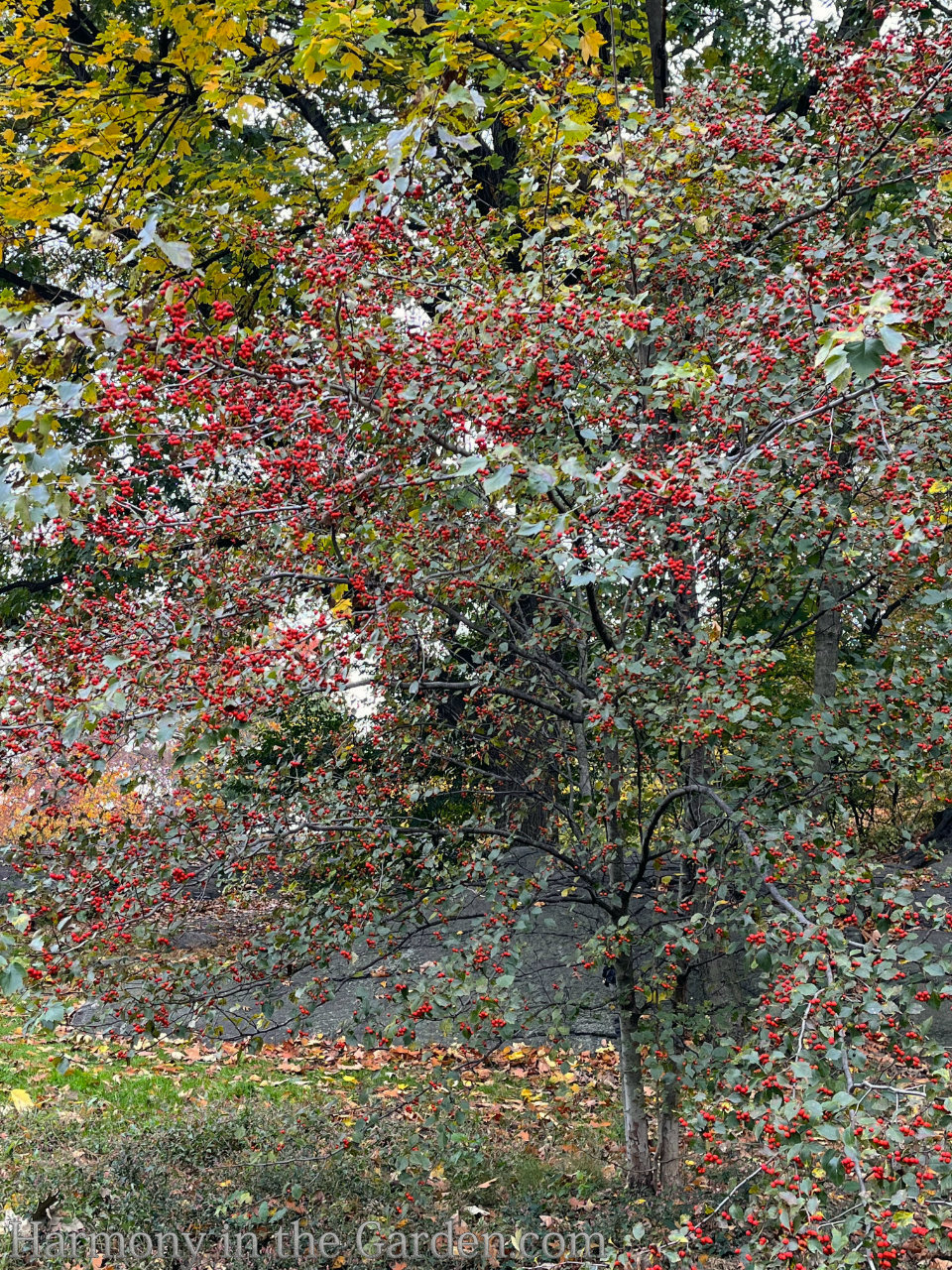
Crataegus pinnatifida (Mountain Hawthorn) zones 5-9
This small to mid-sized tree has it all: compact size, stunning fall foliage, and vibrant winter berries.
Not only that, but once established, it’s fairly drought tolerant and survives with moderate water despite our hot and dry summers.
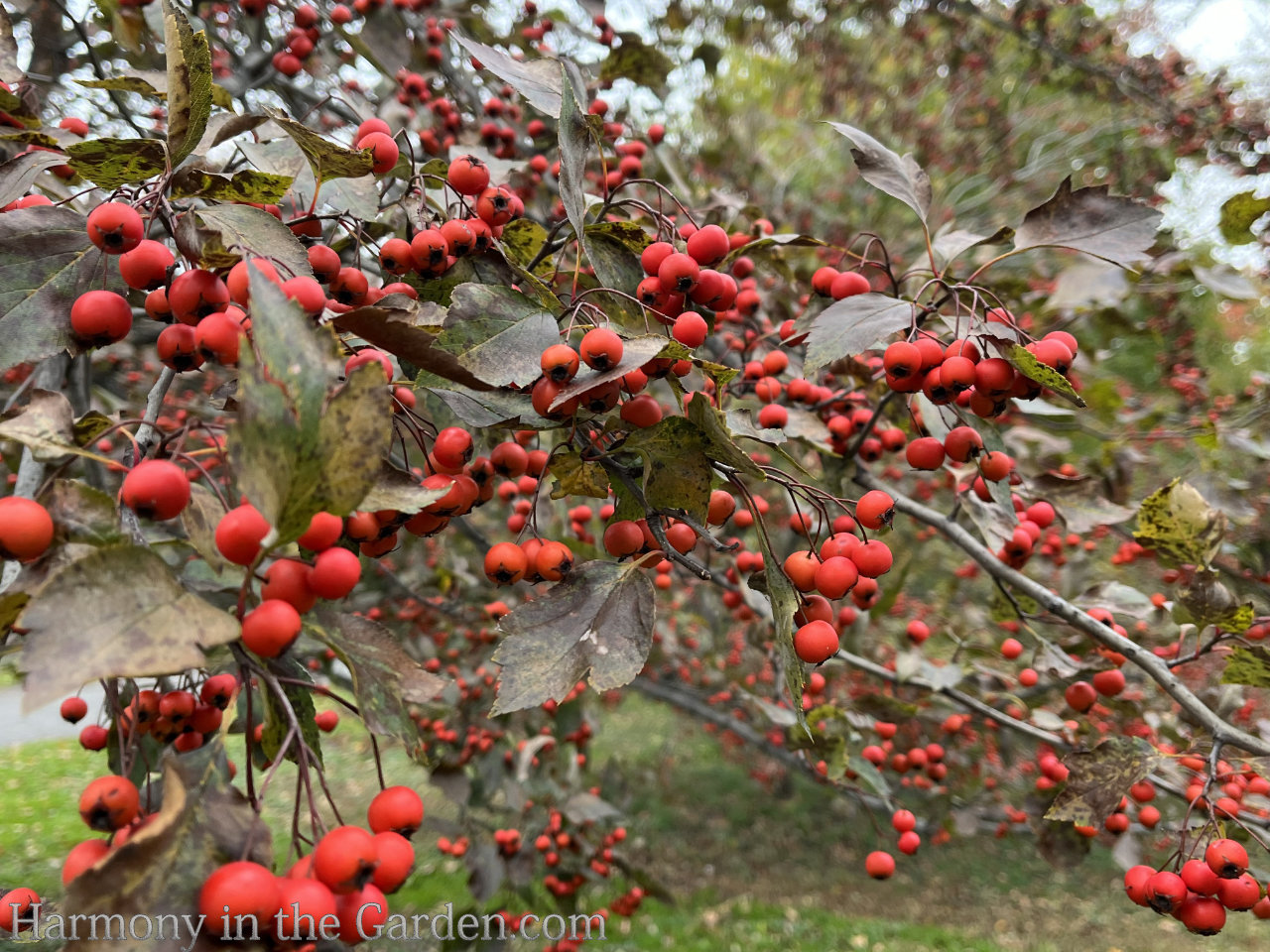

Pyracantha coccinea (Firethorn) zones 5-8
I always say the pyracantha is a shrub people love to hate, thanks to the lethal thorns it can produce.
But despite the painful side to it, I absolutely adore it. Almost as much as the cedar waxwings and robins do!
It not only provides a huge flush of little white flowers in the spring, it’s fast-growing and evergreen (making it a fantastic screening plant – click here to see more), and provides gorgeous winter berries.
In fact, if you’d like to read an amusing story about the chaos created by my pyracantha shrub, click here.
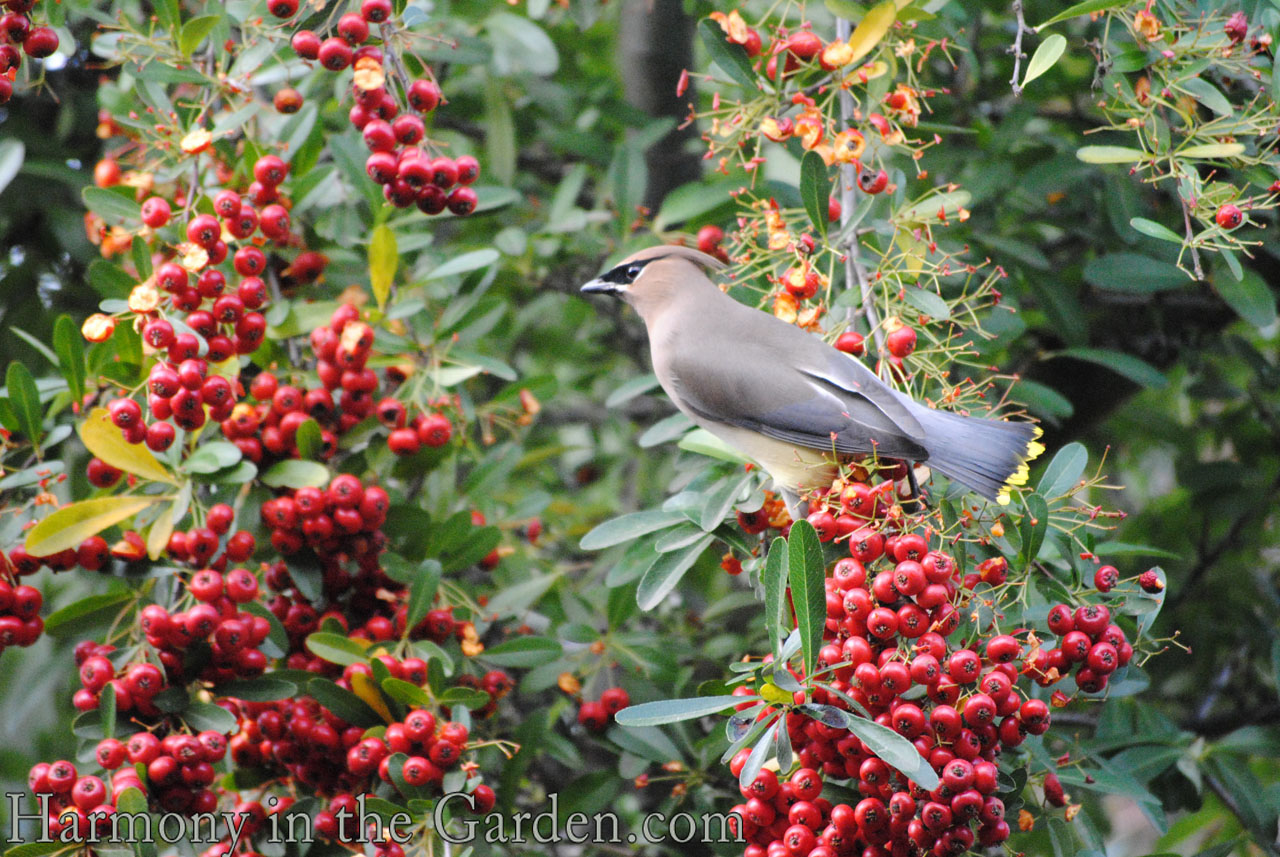
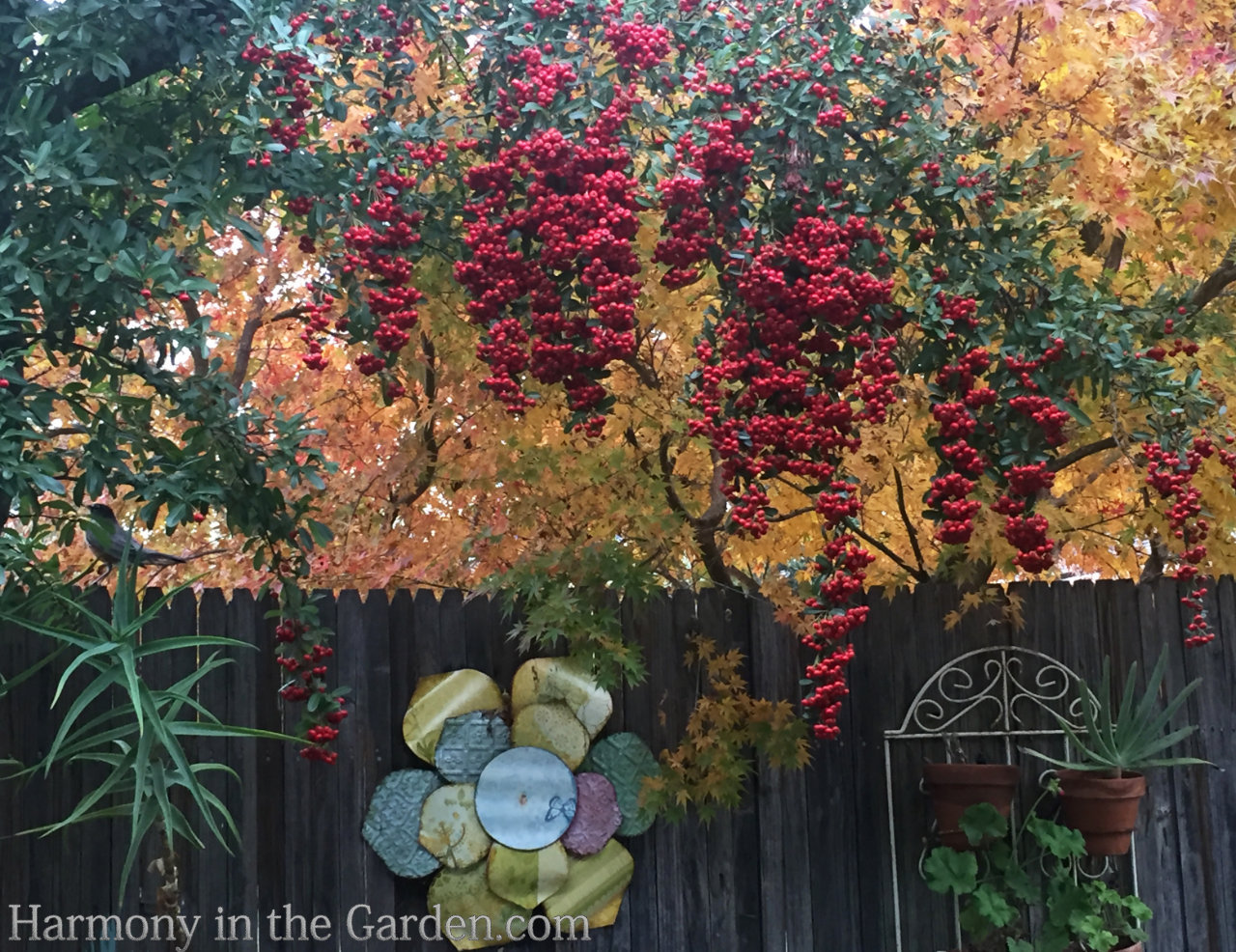
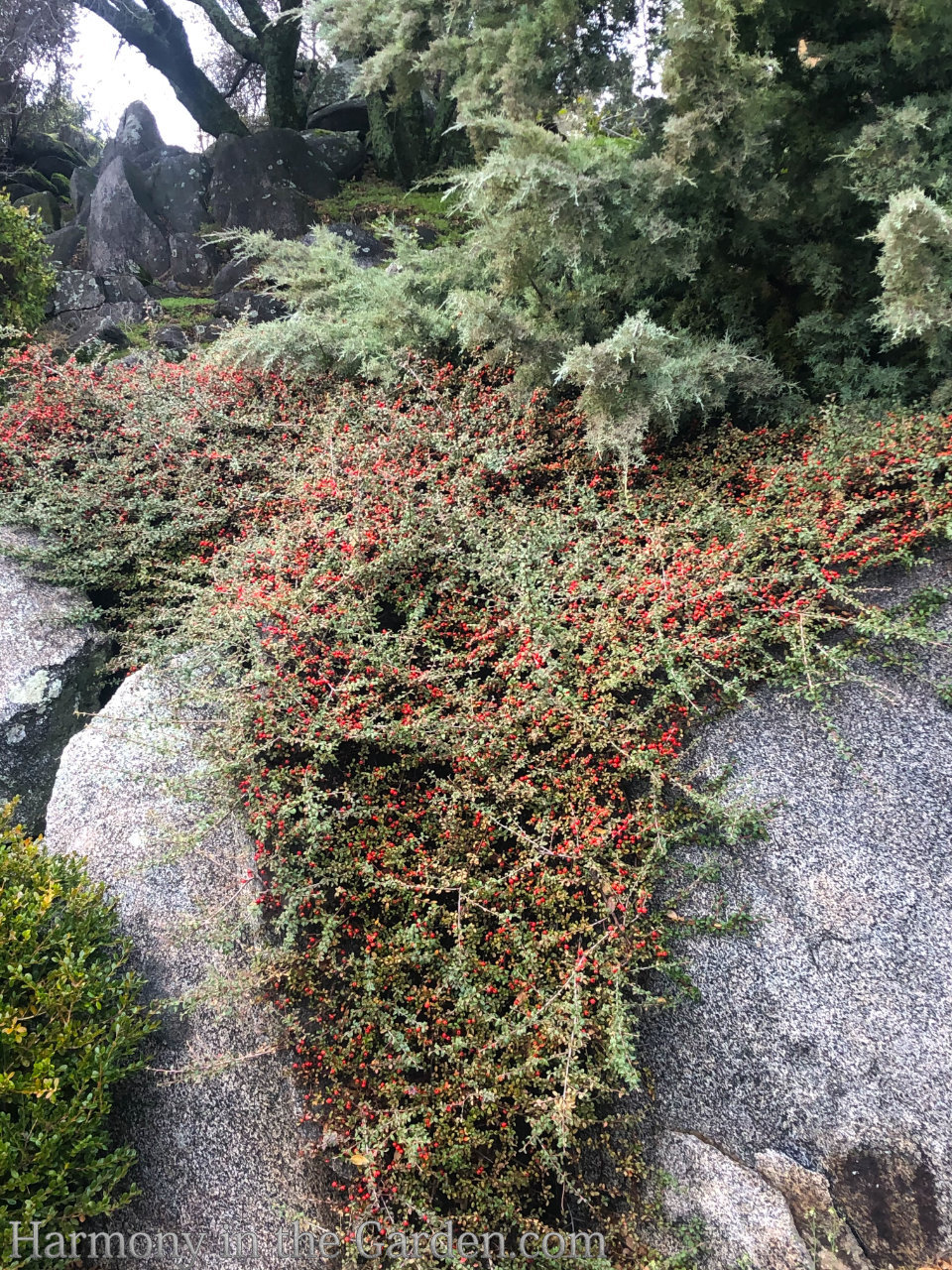
Cotoneaster dammeri (Bearberry) zones 5-8
The cotoneaster family is an indispensable group of plants for winter berries.
For a lower growing cotoneaster, consider the c. dammeri.
Growing to 8″‘x3’, I often plant this variety on hillsides or terraces as its thick, intertwining branches help control soil erosion, or gracefully cascade over a stone wall.
There’s many gorgeous varieties available, from ground covers to tall shrubs, just make sure they’re not categorized as invasive where you garden.
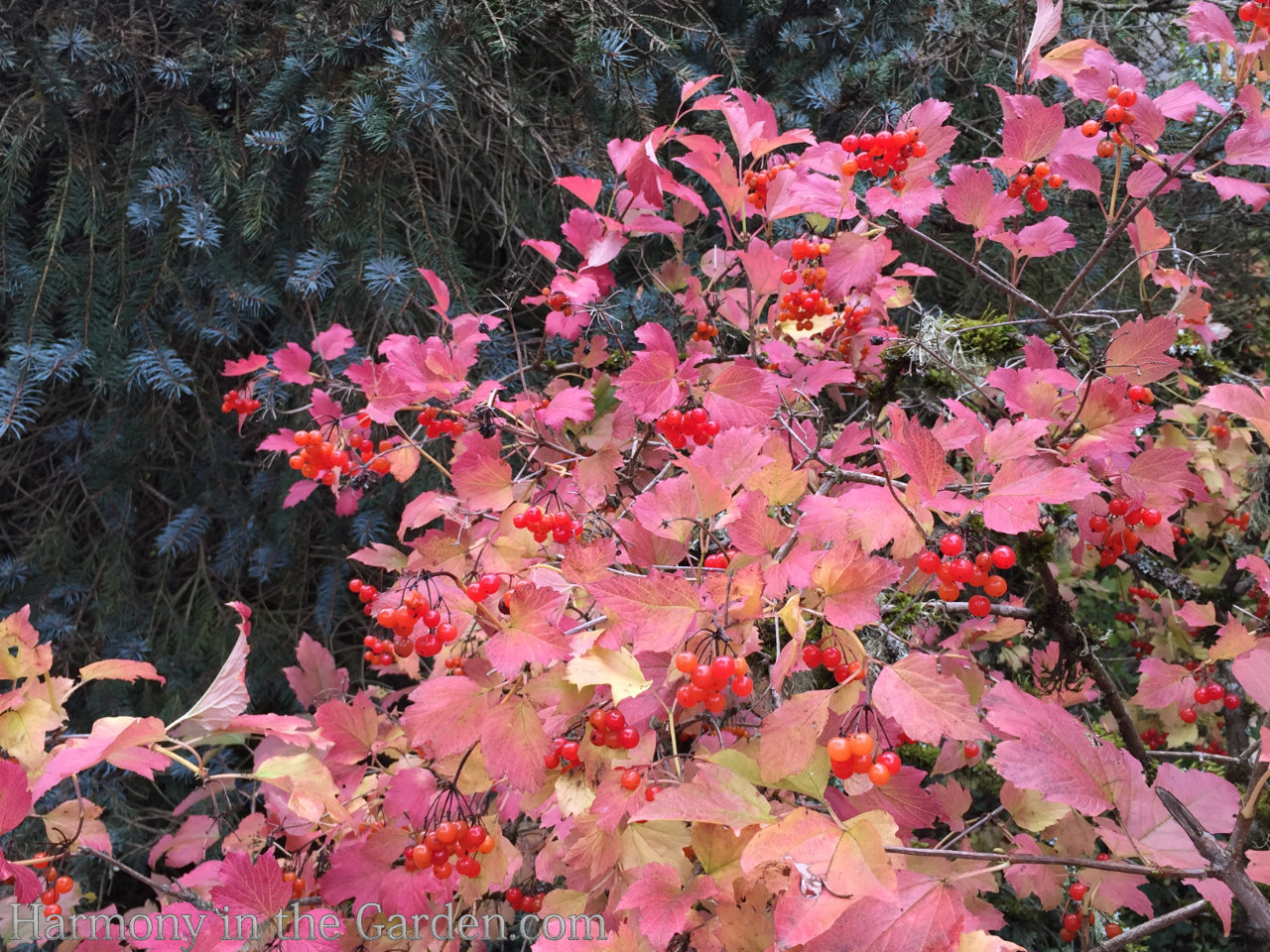
Viburnum opulus ‘Compactum’ (Cranberry Bush) zones 3-8
This is one of the most beautiful fall and winter viburnums ever, with stunning red foliage and vibrant cranberry-like berries.
It’s ideal for the middle of the border, growing to 5’x5′ in just a few seasons.
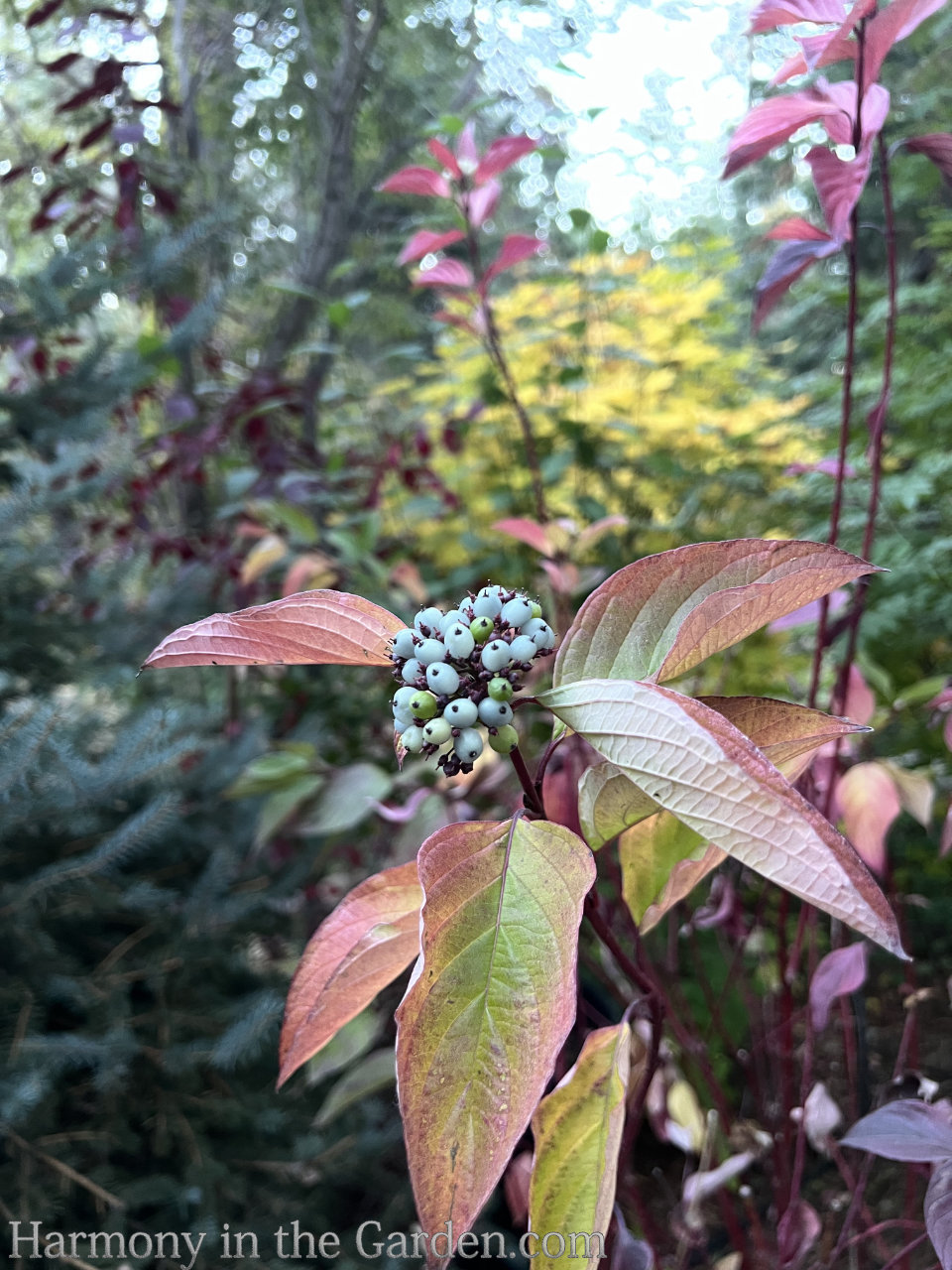
Cornus alba ‘Elegantissima’ (Variegated Red Twig Dogwood) zones 2-8
We have several Red Twig Dogwoods growing in our zone-6 garden at Lake Tahoe, and I don’t know what I love more; their fantastic variegated foliage or the blue-tinged berries.
I think the birds would definitely choose the berries!
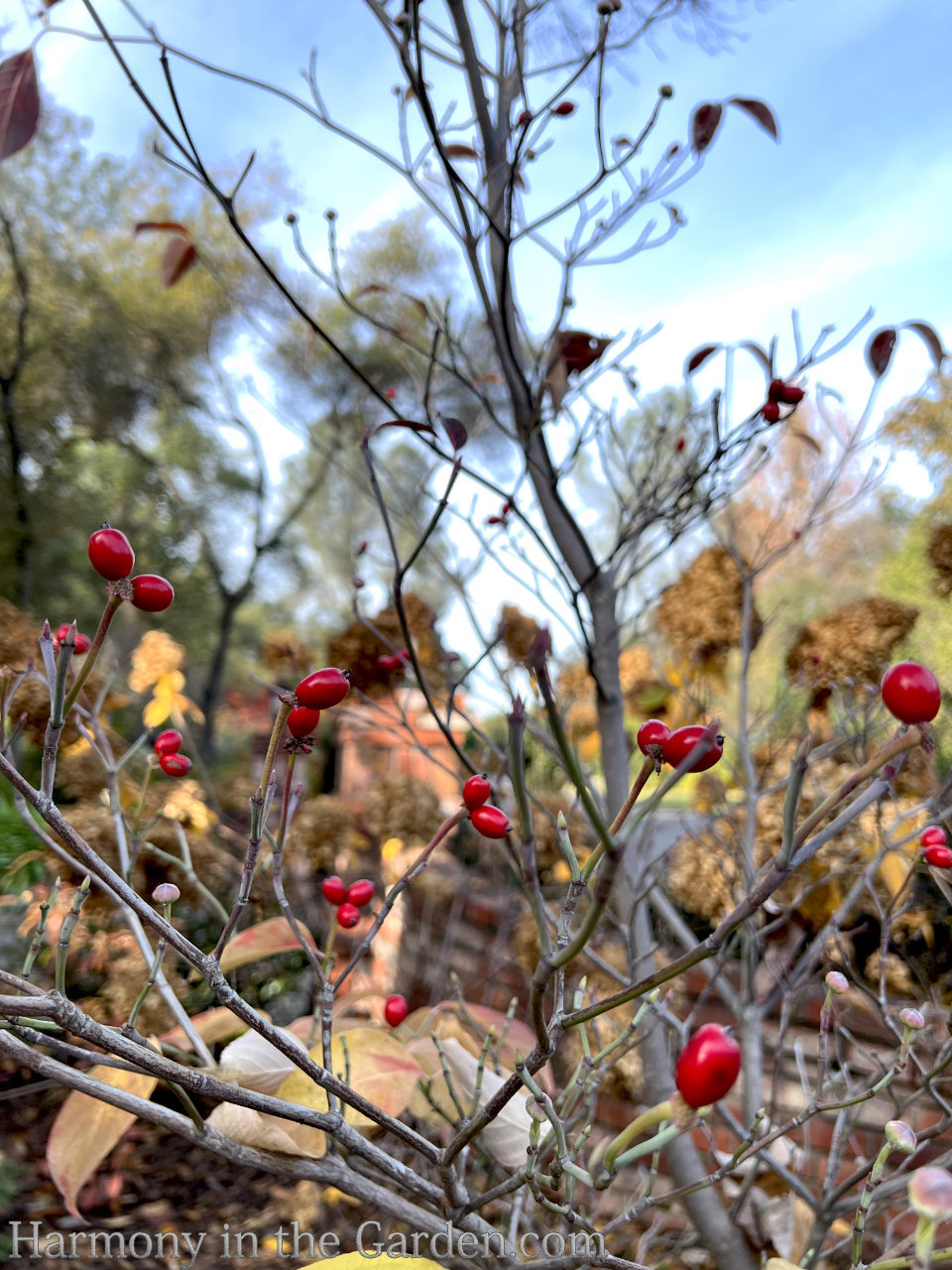
Cornus florida ‘Cloud Nine’ zones 5-9
This is a dogwood that’s more adaptable to my zone 9 garden, able to thrive in our hot summers.
In the spring, it has lovely white flowers, followed by colorful fall foliage with shiny red berries that persist into winter.

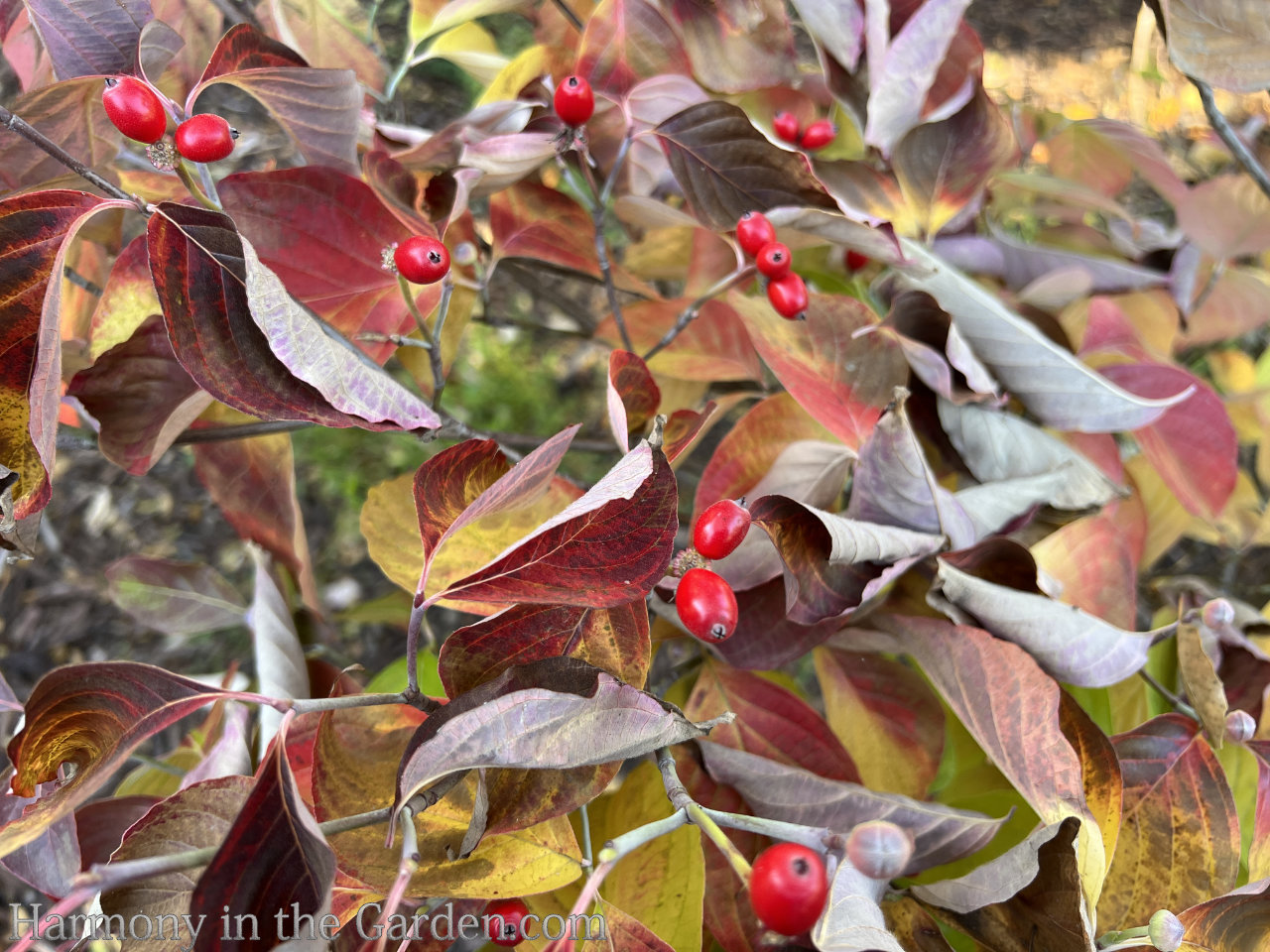

Ilex verticillata (Winterberry Holly) zones 3-9
I originally discovered this at the Little Island garden in New York (click here to see how fantastic this garden looks in the fall!)
The internet says it needs moderate to moist conditions, but since I’ve had fantastic luck with the Golden Oakland Holly in my garden I’m on the hunt for this at a nursery.
You can read more about the Golden Holly, along with my other favorite December plants by clicking here.
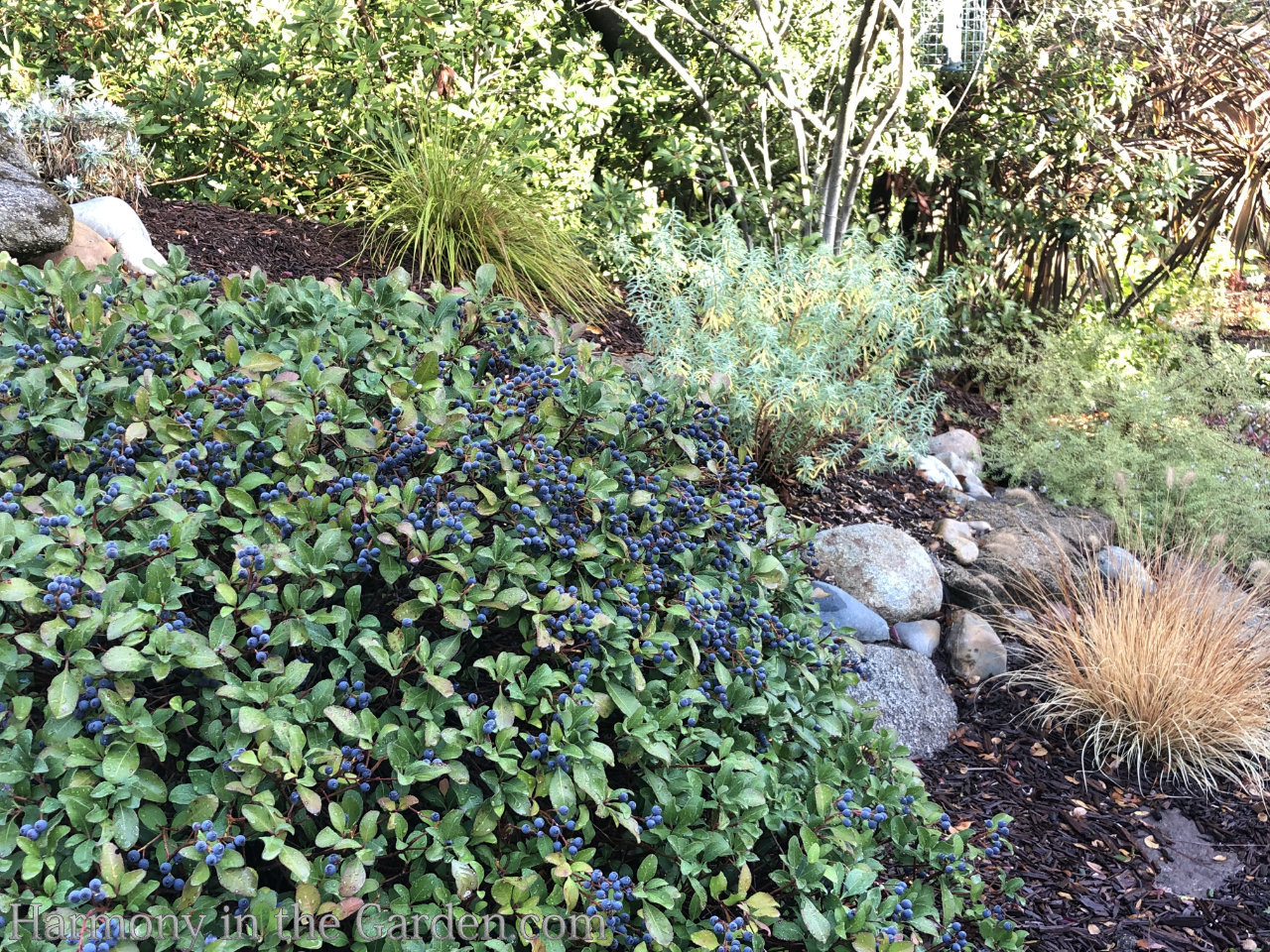
Rhaphiolepis umbellata ‘Blueberry Muffin’ zones 7b-10
I’m always amazed how tough this shrub is, looking glorious throughout the summer in full sun with not a single scorched leaf. Requiring very little water, no less!
The deer will occasionally nibble it, especially when they spot these delicious berries.
But luckily, most of the birds get to the berries first.

Sarcococca rustifolia (Sweet Box) zones 7-9
Whenever possible, I like to plant a sweet box near a client’s front door, where its delightful winter fragrance can be appreciated up close.
But in addition to its heady fragrance, the shiny ink-black berries are a welcome change in color.
It’s an amazing evergreen shrub, growing in the deepest shade, is drought-tolerant, deer-resistant, and blooms in winter. What more could you ask of it!
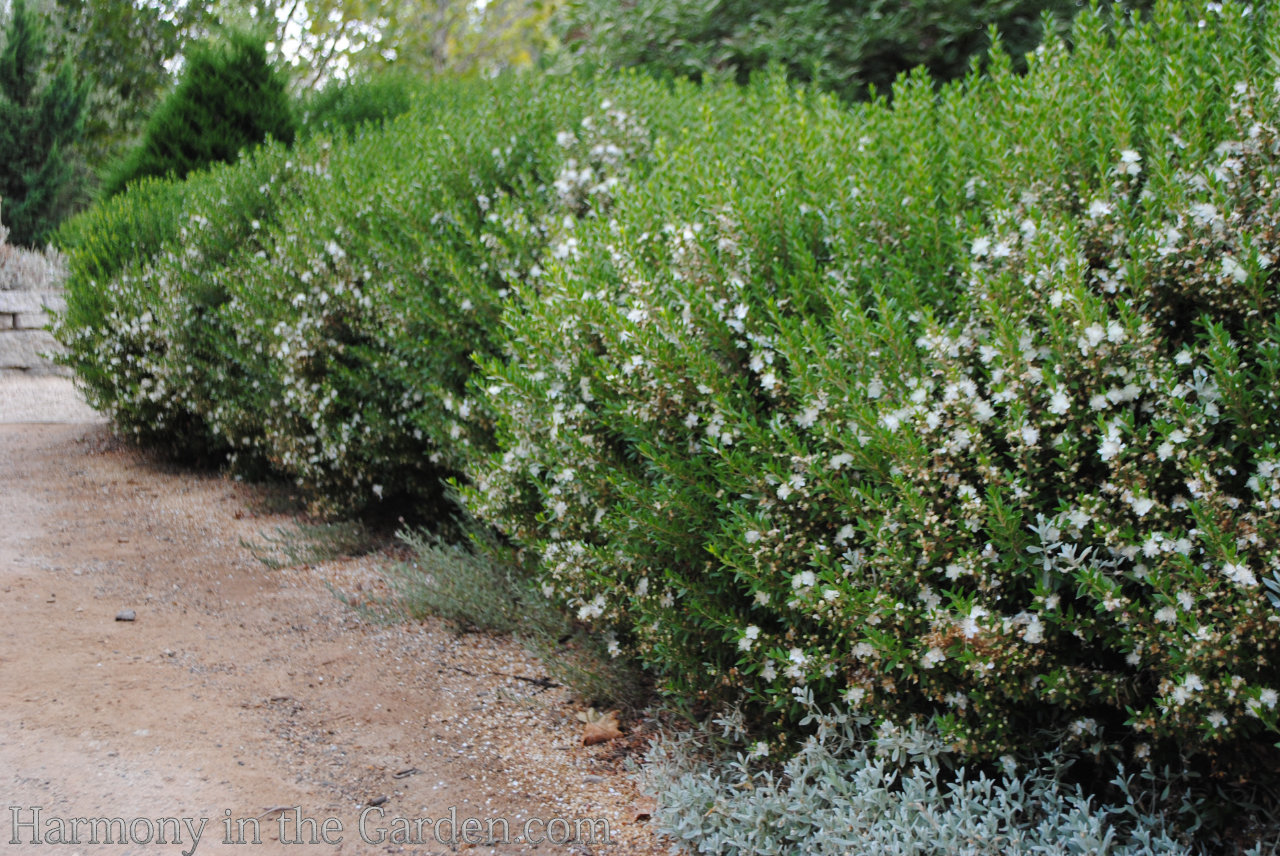
Myrica californica (Pacifica Wax Myrtle) zones 6-11
Myrtle is an unsung hero in the garden and, in my opinion, isn’t used nearly enough! It’s tough as nails, provides flowers and winter berries, has a delicate appearance, and fits in with almost any garden style.
I love how the myrtle was used here instead of boxwood, creating a formal hedge in an informal garden here at Pasadena’s Arlington Garden.
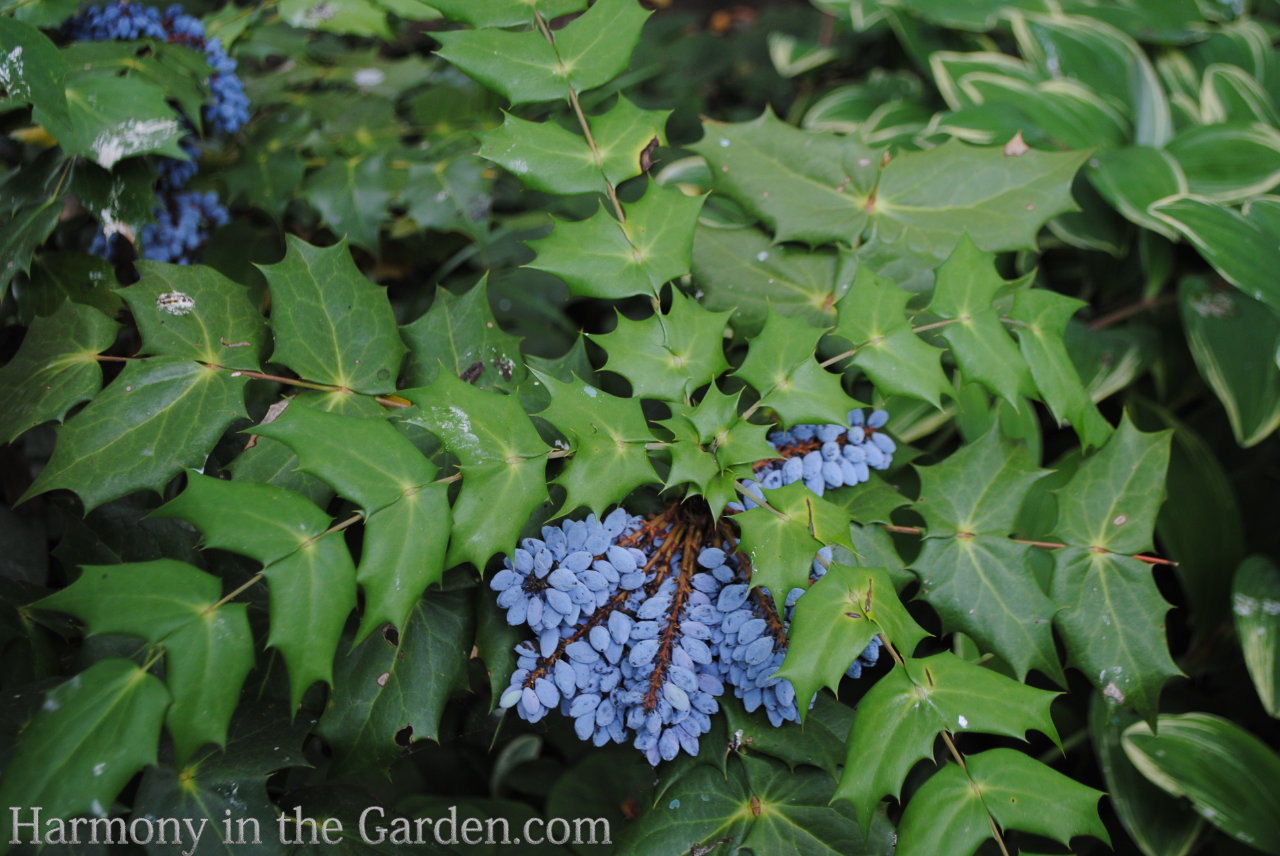
Mahonia aquifolium (Oregon Grape) zones 5-9
Mahonias are a diverse group of shrubs, ranging from low-growing mounding plants to tall, upright focal points. Some have prickly leaves, some have soft and feathery foliage (thinking of you ‘Soft Caress!)
Most have yellow flowers in late autumn, followed by dark blue berries in the winter that birds adore.
For a great article about the Oregon Grape (and why it’s neither specific to Oregon nor a grape), click here.
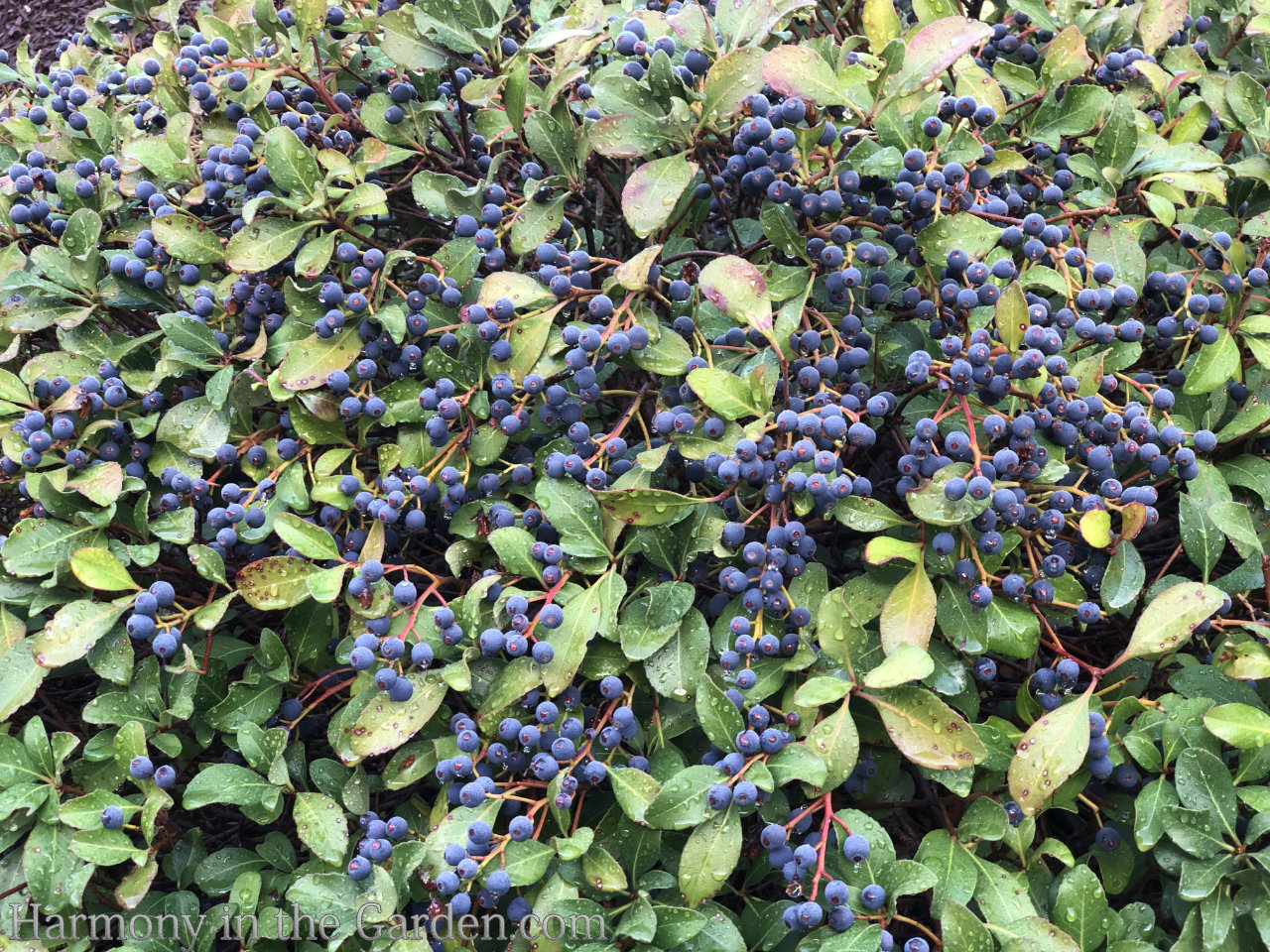
Phew – what a long post!
I realize I’ve only scratched the surface when it comes to winter berries.
I’d love to know what berries bring the birds to your garden?






30 Comments
This is an old article but I still wanted to comment about my favorite Mexican Beautyberry. (C. acuminata). I live in S. Antonio. TX. and it’s a better kind of plant than the American One.
It’s more prolific and vigorous with big clusters of dark colored raspberry fruits. Many nurseries carry it (Almost Eden, Green Canvas Farms, and others) Happy gardening. Lisa Dabbs
Hi Lisa, thanks so much for letting everyone know about your favorite beautyberry. The color of the berries sound gorgeous – lucky you to be able to grow it!
HI Rebecca – my Chionanthus virginica had lovely blue berries. A whole flock of Cedar Waxwings visited for about a week off and on, I don’t usually see them in my garden I also have a C. retusas but it blooms later and doesn’t have many berries. Nan Ray
Hello Nan, and so nice to hear from you! Lucky you to have a beautiful chionanthus in your garden (I didn’t realize they grew in your area!) I saw an amazing one at the Conservatory Garden in NY. Might have to research if they’ll grow here – they’re gorgeous, aren’t they? And I had no idea they had beautiful blue berries! p.s. you once asked if I had a presentation on the Tanner’s amazing garden. Well, I did one for Garden Design which was a huge success and am thinking of doing one for Zoom talks. Your idea was a great one. 🙂
Yes, Rebecca – they grow beautifully here and there are now a few planted here and there – Ladera Nursery sells them. Not only are they quite willing to get by on not two much water, they take our light freezes, have the berries I mentioned and have lovely bright yellow leaves in the falll. It has become my most favorite tree.
You’ve convinced me, Nan – I’m most definitely going to find a spot in my garden for one! Thank you!
Have you ever experienced the Mountain Ash, sometimes referred to as Rowan Berry? Grows wild at Tahoe and particularly at Rubicon River within Desolation Valley; however along the highway in Homewood at about 5000 West Lake Boulevard. White berries in Summer and red in Fall. Most are consumed by now.
Not really enjoyable to eat unless boiled, rinsed, squeezed through a towel with sugar. I have used this method for sore throat when hiking Barker Pass and into Desolation Wilderness area.
Hi Gordy – I’ve seen the beautiful berries of the Mountain Ash at Tahoe but had no idea they’re medicinal!
In my Seattle area garden, the towhees are munching on my ninebark Diabolo berries, and I expect the gorgeous, purple beautyberry berries won’t last very long…. I once made a beautiful wreath using some blue evergreen foliage and beautyberry berries, and the birds found it on the porch and stripped off every single berry!
Thanks for the great post. I love all the seasons in the garden, each with its own stars.
You may want to correct the plant label on your mahonia (it’s labeled as Myrica from the previous plant entry). Do you know which Myrica californica was used in that hedge? It sure works well! The straight species gets huge!
Hello, Luba, and thanks for catching that mistake! I once had a beautiful Easter wreath on my front door, decorated with faux robin eggs. It lasted a few weeks until a scrub jay discovered it and destroyed all the eggs. 🙁 You’re so fortunate to be able to grow beautyberries (it’s just a little too hot in my climate for them to thrive) I’m not sure which variety of myrtle was used in that hedge, but if it wasn’t a Pacific Wax Myrtle, I wonder if it could be Myrica cerifera ‘Don’s Dwarf’ which grows much smaller.
Your garden looks gorgeous – where do you live? I live in SoCal and grow all year (though I do know one can grow certain crops in the winter in colder locations).
Hi Melanie – thanks for the compliment! I live in the Bay Area, Zone 9, and am lucky that I can grow year-round (with a few exceptions, of course)
After visiting a nearby garden these past few days, plus seeing your post, I see something else I forget to put in my rushed designs’ arsenal…plants with winter berries! Even some cacti keep yellow fruit on them over winter.
Hi David – so nice to hear from you! I’m working on a design this week and I’m having to remind myself to include winter berries. I think when we’re thinking so far ahead about what the garden will look like it can be an easy thing to forget. Cactus winter fruit – that’s something I know nothing about but I bet it’s beautiful!
What a great selections. I only have few Nandinas and cestrum in my garden. I planted some toyon plants but so far haven’t flowered as they are small.
Birds love the persimmons though and the olives make a tasty morsel too when ripe.
Yesterday I saw a varied thrush couple in the garden, first time since buying the house 10 years ago. I wonder whether the nandina attracted them.
You garden is so lovely and peaceful, very inspirational!
Laura – how funny! Just yesterday I was telling my mother that a varied thrush has been hanging out in my garden this winter – first time ever. She said she had several in their garden (in Meadow Vista, north of you) until the temps dipped down into the low twenties. They must’ve flown to our gardens to keep warm! 😉
Great post, Rebecca. I’m going to share it with a friend who just mentioned a desire to attract more birds to her garden. In my own, I have Heteromeles, Nandina and Asparagus fern. The berries on the Arbutus ‘Marina’ are edible but don’t seem to be a major draw (although the hummingbirds love the flowers). To bring in berries of a different color, I’m thinking of adding Mahonia.
Hi Kris, and thanks for reminding me about the berries of the Asparagus fern! You’re right about the arbutus berries – they’re beautiful but they must not taste that great to the birds because mine end up falling to the ground, colorful but uneaten.
Rebecca,loved and appreciated this article! I was just out for a walk yesterday afternoon and admiring an exquisite,berry loaded shrub (maybe a cottoneaster variety)in our neighborhood and was reminded that we need to get photos of a few of these cheerful berry branches for our website. Thank you also for helping me to identify some of the local varieties that we often see. Hard to choose which I like best and I now understand why there’s a hiking trail called The Toyon trail up at Hidden Villa!
Glad you enjoyed the article, Nancy! I haven’t hiked the Toyon Trail at Hidden Villa but I think I need to add that to my list. I love that place! You’re welcome to use any photos of berries that I have for your site – just let me know and I’ll send you the pic.
Truly harmony in the garden…enjoy every minute of your lovely garden!
Thank you, Cristina. I’m glad you enjoy my garden, if not in person then at least virtually!
What an inspiration as I seek to lure more birds into my yard so I can paint them!
I currently have Chinese Beauty Berries which I adore (such a pretty intense violet) but the birds seem to ignore.
Oh, how lucky that you’re able to grow those beautiful berries, Marie! I’ve never had luck with them in my own garden. They’re such a gorgeous berry, aren’t they? Maybe the birds think they’re too pretty to eat…
How very lucky to have such a garden. I had 1/3 acre before we retired to a gated Community and I have a small patio. It is gated to keep the deer from feasting. I can grow succulents, and they give me some lovely colour, nothing like yours of course. I had all that,but took it for granted. Don’t ever do that. enjoy every leaf and blade of grass. I love where I am,with wild turkeys strutting their stuff,and deer sleeping in the bushes in my front yard. I miss my Los Altos garden. Keep those beautiful articles coming. Love and Hugs, Jean.
Thanks, Jean. My parents are seriously thinking about moving into a retirement community and I just know my mother will miss her garden terribly. We’ve talked a lot about the positives that come with the change (as well as the negatives) so I can imagine what a hard decision it must’ve been for you. I’m glad to hear you’re enjoying the wildlife that visits and happy to hear that they can’t get to your precious succulents. Thanks for stopping by my blog this morning!
Beautiful winter garden pictures. Very inspiring. I am going to plan a spot for Cotoneaster parneyi. I forgot how much I like that plant, even though I am not that crazy about other Cotoneasters. Thanks for a great post.
Thank you, Carol. I’m glad you enjoyed my post and will be planting a C. parneyi. It’s such a fabulous shrub, isn’t it? I have two designs I’ll be working on this month and I think I’ll make a note to include one (or two) of them in their gardens. They make such a lovely screening plant, too.
Dear Rebecca,
What a mouthwatering visual delight. Nandina, cotoneaster, ilexes are all winners. But I must tell you that there is something so very sweet and endearing about Sarcococca rustifolia — perhaps because it’s NOT an outlandish star of the winter garden, that i am drawn to it the most. It’s incredible scent is intoxicating. Thanks for my early morning romp through your winter garden. A great way to start my week. xo-Fran
So that was YOU I heard romping through my garden this morning, Fran? 😉 I’m so glad you enjoyed my post. My Sarcococca is just about to bloom and I can’t wait to pick a bouquet to perfume my bedroom. Like you, I also love that discreet, lovely shrub. Have a beautiful week!